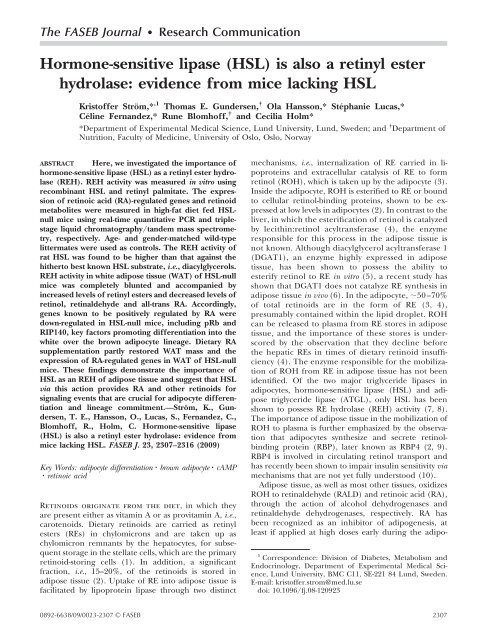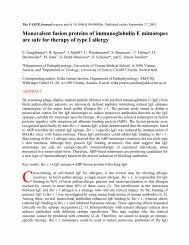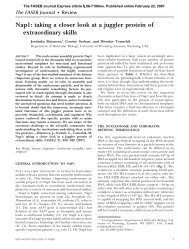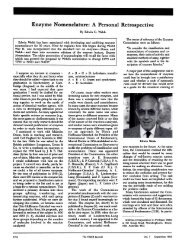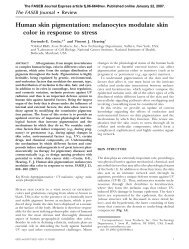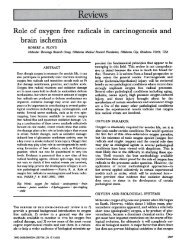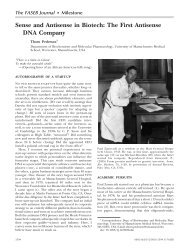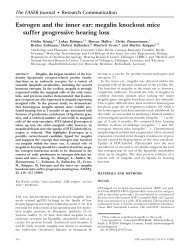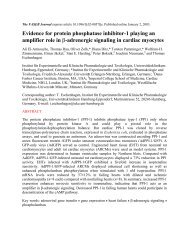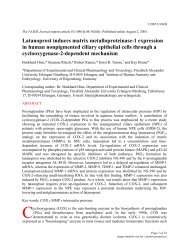(HSL) is also a retinyl ester hydrolase: evidence from mice lacking ...
(HSL) is also a retinyl ester hydrolase: evidence from mice lacking ...
(HSL) is also a retinyl ester hydrolase: evidence from mice lacking ...
You also want an ePaper? Increase the reach of your titles
YUMPU automatically turns print PDFs into web optimized ePapers that Google loves.
The FASEB Journal Research Communication<br />
Hormone-sensitive lipase (<strong>HSL</strong>) <strong>is</strong> <strong>also</strong> a <strong>retinyl</strong> <strong>ester</strong><br />
<strong>hydrolase</strong>: <strong>evidence</strong> <strong>from</strong> <strong>mice</strong> <strong>lacking</strong> <strong>HSL</strong><br />
Kr<strong>is</strong>toffer Ström,* ,1 Thomas E. Gundersen, † Ola Hansson,* Stéphanie Lucas,*<br />
Céline Fernandez,* Rune Blomhoff, † and Cecilia Holm*<br />
*Department of Experimental Medical Science, Lund University, Lund, Sweden; and † Department of<br />
Nutrition, Faculty of Medicine, University of Oslo, Oslo, Norway<br />
ABSTRACT Here, we investigated the importance of<br />
hormone-sensitive lipase (<strong>HSL</strong>) as a <strong>retinyl</strong> <strong>ester</strong> <strong>hydrolase</strong><br />
(REH). REH activity was measured in vitro using<br />
recombinant <strong>HSL</strong> and <strong>retinyl</strong> palmitate. The expression<br />
of retinoic acid (RA)-regulated genes and retinoid<br />
metabolites were measured in high-fat diet fed <strong>HSL</strong>null<br />
<strong>mice</strong> using real-time quantitative PCR and triplestage<br />
liquid chromatography/tandem mass spectrometry,<br />
respectively. Age- and gender-matched wild-type<br />
littermates were used as controls. The REH activity of<br />
rat <strong>HSL</strong> was found to be higher than that against the<br />
hitherto best known <strong>HSL</strong> substrate, i.e., diacylglycerols.<br />
REH activity in white adipose t<strong>is</strong>sue (WAT) of <strong>HSL</strong>-null<br />
<strong>mice</strong> was completely blunted and accompanied by<br />
increased levels of <strong>retinyl</strong> <strong>ester</strong>s and decreased levels of<br />
retinol, retinaldehyde and all-trans RA. Accordingly,<br />
genes known to be positively regulated by RA were<br />
down-regulated in <strong>HSL</strong>-null <strong>mice</strong>, including pRb and<br />
RIP140, key factors promoting differentiation into the<br />
white over the brown adipocyte lineage. Dietary RA<br />
supplementation partly restored WAT mass and the<br />
expression of RA-regulated genes in WAT of <strong>HSL</strong>-null<br />
<strong>mice</strong>. These findings demonstrate the importance of<br />
<strong>HSL</strong> as an REH of adipose t<strong>is</strong>sue and suggest that <strong>HSL</strong><br />
via th<strong>is</strong> action provides RA and other retinoids for<br />
signaling events that are crucial for adipocyte differentiation<br />
and lineage commitment.—Ström, K., Gundersen,<br />
T. E., Hansson, O., Lucas, S., Fernandez, C.,<br />
Blomhoff, R., Holm, C. Hormone-sensitive lipase<br />
(<strong>HSL</strong>) <strong>is</strong> <strong>also</strong> a <strong>retinyl</strong> <strong>ester</strong> <strong>hydrolase</strong>: <strong>evidence</strong> <strong>from</strong><br />
<strong>mice</strong> <strong>lacking</strong> <strong>HSL</strong>. FASEB J. 23, 2307–2316 (2009)<br />
Key Words: adipocyte differentiation � brown adipocyte � cAMP<br />
� retinoic acid<br />
Retinoids originate <strong>from</strong> the diet, in which they<br />
are present either as vitamin A or as provitamin A, i.e.,<br />
carotenoids. Dietary retinoids are carried as <strong>retinyl</strong><br />
<strong>ester</strong>s (REs) in chylomicrons and are taken up as<br />
chylomicron remnants by the hepatocytes, for subsequent<br />
storage in the stellate cells, which are the primary<br />
retinoid-storing cells (1). In addition, a significant<br />
fraction, i.e., 15–20%, of the retinoids <strong>is</strong> stored in<br />
adipose t<strong>is</strong>sue (2). Uptake of RE into adipose t<strong>is</strong>sue <strong>is</strong><br />
facilitated by lipoprotein lipase through two d<strong>is</strong>tinct<br />
0892-6638/09/0023-2307 © FASEB<br />
mechan<strong>is</strong>ms, i.e., internalization of RE carried in lipoproteins<br />
and extracellular catalys<strong>is</strong> of RE to form<br />
retinol (ROH), which <strong>is</strong> taken up by the adipocyte (3).<br />
Inside the adipocyte, ROH <strong>is</strong> <strong>ester</strong>ified to RE or bound<br />
to cellular retinol-binding proteins, shown to be expressed<br />
at low levels in adipocytes (2). In contrast to the<br />
liver, in which the <strong>ester</strong>ification of retinol <strong>is</strong> catalyzed<br />
by lecithin:retinol acyltransferase (4), the enzyme<br />
responsible for th<strong>is</strong> process in the adipose t<strong>is</strong>sue <strong>is</strong><br />
not known. Although diacylglycerol acyltransferase 1<br />
(DGAT1), an enzyme highly expressed in adipose<br />
t<strong>is</strong>sue, has been shown to possess the ability to<br />
<strong>ester</strong>ify retinol to RE in vitro (5), a recent study has<br />
shown that DGAT1 does not catalyze RE synthes<strong>is</strong> in<br />
adipose t<strong>is</strong>sue in vivo (6). In the adipocyte, �50–70%<br />
of total retinoids are in the form of RE (3, 4),<br />
presumably contained within the lipid droplet. ROH<br />
can be released to plasma <strong>from</strong> RE stores in adipose<br />
t<strong>is</strong>sue, and the importance of these stores <strong>is</strong> underscored<br />
by the observation that they decline before<br />
the hepatic REs in times of dietary retinoid insufficiency<br />
(4). The enzyme responsible for the mobilization<br />
of ROH <strong>from</strong> RE in adipose t<strong>is</strong>sue has not been<br />
identified. Of the two major triglyceride lipases in<br />
adipocytes, hormone-sensitive lipase (<strong>HSL</strong>) and adipose<br />
triglyceride lipase (ATGL), only <strong>HSL</strong> has been<br />
shown to possess RE <strong>hydrolase</strong> (REH) activity (7, 8).<br />
The importance of adipose t<strong>is</strong>sue in the mobilization of<br />
ROH to plasma <strong>is</strong> further emphasized by the observation<br />
that adipocytes synthesize and secrete retinolbinding<br />
protein (RBP), later known as RBP4 (2, 9).<br />
RBP4 <strong>is</strong> involved in circulating retinol transport and<br />
has recently been shown to impair insulin sensitivity via<br />
mechan<strong>is</strong>ms that are not yet fully understood (10).<br />
Adipose t<strong>is</strong>sue, as well as most other t<strong>is</strong>sues, oxidizes<br />
ROH to retinaldehyde (RALD) and retinoic acid (RA),<br />
through the action of alcohol dehydrogenases and<br />
retinaldehyde dehydrogenases, respectively. RA has<br />
been recognized as an inhibitor of adipogenes<strong>is</strong>, at<br />
least if applied at high doses early during the adipo-<br />
1 Correspondence: Div<strong>is</strong>ion of Diabetes, Metabol<strong>is</strong>m and<br />
Endocrinology, Department of Experimental Medical Science,<br />
Lund University, BMC C11, SE-221 84 Lund, Sweden.<br />
E-mail: kr<strong>is</strong>toffer.strom@med.lu.se<br />
doi: 10.1096/fj.08-120923<br />
2307
genic process (11). Low doses of RA, however, have<br />
been shown to promote preadipocyte differentiation<br />
(12). RA <strong>is</strong> believed to exert its effects on adipogenes<strong>is</strong><br />
mainly through its role as a ligand for the retinoid X<br />
receptor (RXR), which heterodimerizes with perox<strong>is</strong>ome<br />
proliferator-activated receptor � (PPAR�), the<br />
crucial transcription factor for adipogenes<strong>is</strong> and survival<br />
of mature adipocytes (13, 14). RALD, which up to<br />
now was believed to play a role only in the eye, was<br />
recently shown to be a potent inhibitor of adipogenes<strong>is</strong>,<br />
operating through both RXR-dependent and RXRindependent<br />
mechan<strong>is</strong>ms (15).<br />
<strong>HSL</strong> <strong>is</strong> best known as a lipase hydrolyzing acylglycerides.<br />
Its role in catecholamine-stimulated hydrolys<strong>is</strong> of<br />
stored triacylglycerols and, in particular, diacylglycerols<br />
has been demonstrated in studies of <strong>HSL</strong>-null <strong>mice</strong> (16,<br />
17). Despite its prominent role in lipolys<strong>is</strong>, <strong>HSL</strong>-null<br />
<strong>mice</strong> are not obese and exhibit a remarkable res<strong>is</strong>tance<br />
to development of obesity following challenge with a<br />
long-term high fat diet (HFD) (18, 19). The res<strong>is</strong>tance<br />
to diet-induced obesity <strong>is</strong> accompanied by impaired<br />
adipogenes<strong>is</strong> (18, 19) and attainment of brown adipocyte<br />
features of WAT (18), suggesting that <strong>HSL</strong> plays<br />
additional, yet unexplored, roles in adipose t<strong>is</strong>sue. <strong>HSL</strong><br />
exhibits broad substrate specificity and besides acylglycerides<br />
it hydrolyzes chol<strong>ester</strong>yl <strong>ester</strong>s, REs, lipoidal<br />
<strong>ester</strong>s, and water-soluble <strong>ester</strong>s. The biological significance<br />
of these other activities, however, <strong>is</strong> poorly understood.<br />
Results <strong>from</strong> studies using partially purified<br />
preparations of <strong>HSL</strong> as well as transfected CHO cells,<br />
have indicated that the REH activity of <strong>HSL</strong> <strong>is</strong> approximately<br />
one tenth of the activity against triacylglycerol<br />
(7). Furthermore, following stimulation of cultured<br />
adipocytes with dibuturyl cAMP, ROH was released to<br />
the medium in parallel with decreased RE stores of the<br />
cell, suggesting that a cAMP-regulated enzyme, such as<br />
<strong>HSL</strong>, <strong>is</strong> responsible for th<strong>is</strong> mobilization. The biological<br />
significance of <strong>HSL</strong> as an REH in adipose t<strong>is</strong>sue has,<br />
however, never been directly addressed. We therefore<br />
utilized purified preparations of recombinant <strong>HSL</strong>, as<br />
well as <strong>HSL</strong>-null <strong>mice</strong>, to investigate the REH activity of<br />
<strong>HSL</strong> and the consequences of <strong>HSL</strong> deficiency for ROH<br />
metabol<strong>is</strong>m in adipose t<strong>is</strong>sue.<br />
MATERIALS AND METHODS<br />
Animal experiments<br />
The study was reviewed and approved by the Ethical Committee<br />
in Malmö/Lund, Lund, Sweden (license no. M162-05)<br />
and <strong>is</strong> in accordance with the Council of Europe Convention<br />
(ETS 123). <strong>HSL</strong>-null <strong>mice</strong> were generated by targeted d<strong>is</strong>ruption<br />
of the <strong>HSL</strong> gene in 129SV-derived embryonic stem cells<br />
as described elsewhere (16). Animals used were <strong>from</strong> the<br />
same embryonic stem cell colony. Animals in the different<br />
groups were littermates and had a mixed genetic background<br />
<strong>from</strong> the inbred strains C57BL/6J and SV129 (16). The<br />
animals were maintained in a temperature-controlled room<br />
(22 � C) on a 12-h light-dark cycle. Mice, 16–20 wk of age, were<br />
fed a chow diet ad libitum (control) (11% energy <strong>from</strong> fat) or<br />
a high-fat diet (HFD) (58% energy <strong>from</strong> fat) (Research Diets;<br />
products D12310 and D12309, respectively; Research Diets,<br />
New Brunswick, NJ, USA). After sacrificing the <strong>mice</strong>, t<strong>is</strong>sues<br />
were rapidly d<strong>is</strong>sected, snap frozen, and stored in liquid<br />
nitrogen before in vitro analyses.<br />
For the diet intervention studies, regular HFD (see above),<br />
containing 0.8 g/kg diet of <strong>retinyl</strong> palmitate, and <strong>retinyl</strong><br />
<strong>ester</strong>-free HFD, supplemented with 10 mg all-trans retinoic<br />
acid (atRA)/kg diet (product D05081101), were obtained<br />
<strong>from</strong> Research Diets. The studies were initiated by feeding<br />
mating <strong>mice</strong> the two respective diets. Thus, diets were provided<br />
<strong>from</strong> pregnancy to weaning of the pups and maintained<br />
until the age of 5 mo, after which the <strong>mice</strong> were killed and<br />
t<strong>is</strong>sues were d<strong>is</strong>sected. Mice fed the atRA-supplemented diet<br />
were divided into three groups; one group was fed the higher<br />
concentration throughout the entire study, and two groups<br />
were initially fed the higher concentration, but after 2.5 mo<br />
were switched to a diet containing 1 and 0.5 mg atRA/kg diet,<br />
respectively, by mixing the original atRA-containing diet (10<br />
mg/kg diet) with <strong>retinyl</strong> <strong>ester</strong>-free HFD. Body weight and<br />
food intake were measured throughout the study. Blood<br />
samples were drawn by retro-orbital puncture <strong>from</strong> female<br />
animals in the fed state.<br />
Recombinant <strong>HSL</strong> and enzyme activity measurements<br />
Recombinant rat and human <strong>HSL</strong>, purified to apparent<br />
homogeneity (�95% protein purity) (20–22), were assayed<br />
against trioloein (TO), 1-mono-oleoyl-2-O-mono-oleylglycerol<br />
(MOME, a diolein analog), chol<strong>ester</strong>yl oleate (CO), and<br />
<strong>retinyl</strong> palmitate (RP) substrates, as described previously (20,<br />
23, 24). Briefly, unlabeled and labeled substrates were emulsified<br />
with phospholipids in 100 mM KH 2PO 4 (pH 7.0) and<br />
5% defatted BSA (fatty acid acceptor) using sonication, to<br />
yield final substrate concentrations of 5 mM (TO and<br />
MOME), 0.45 mM (CO), and 0.5 mM (RP). The purified<br />
enzyme preparations were in 5 mM NaH 2PO 4 (pH 7.4), 1 mM<br />
dithioerythritol, 50% glycerol, and 0.2% C 13E 12 (a detergent<br />
<strong>from</strong> the polyoxyethylene series) and were diluted with 20<br />
mM KH 2PO 4 (pH 7.0), 1 mM EDTA, 1 mM dithioerythritol,<br />
and 0.02% defatted BSA to noninhibitory detergent concentrations<br />
before assay (23). Unit (U) <strong>is</strong> defined as micromoles<br />
of fatty acids released per minute at 37 � C.<br />
Determination of RALD and RA in WAT with LC-MS/MS<br />
To extract RALD and RA <strong>from</strong> WAT, 3 vol of 2-propanol<br />
containing a 13 C-labeled stable <strong>is</strong>otope of atRA as internal<br />
standard was added to WAT pieces (200 mg), followed by<br />
homogenization with a motorized homogenizer (Pro Scientific,<br />
Oxford, CT, USA), shaking for 15 min, and centrifugation<br />
(10 min, 10 � C, 2700 g). The whole procedure was<br />
performed under red light. An aliquot of 100 �l was analyzed<br />
on a 4000 Q TRAP LC-MS/MS, triple quadruple mass spectrometer<br />
with APCI ionization (Applied Biosystems, Foster<br />
City, CA, USA), as described previously (25) except that the<br />
separating column was a Supelco ABZ Plus, 70 mm � 3mm<br />
ID, 3-�m particles (Supelco/Sigma-Aldrich, St. Lou<strong>is</strong>, MO,<br />
USA). The additional MRM transitions monitored for retinal<br />
were 285.2-161 (quantifier) and 385.2-133 (qualifier).<br />
Determination of ROH in plasma and WAT, and RE in<br />
WAT using LC-UV<br />
One hundred microliters of plasma or �200 mg of WAT was<br />
diluted with 450 �l 2-propanol containing <strong>retinyl</strong> propionate<br />
as an internal standard and butylated hydroxytoluene as an<br />
antioxidant. After thorough mixing (15 min) and centrifugation<br />
(10 min, 4000 g at 10 � C), an aliquot of 20 �l was injected<br />
2308 Vol. 23 July 2009 The FASEB Journal<br />
STRÖM ET AL.
<strong>from</strong> the supernatant into the HPLC system. HPLC was<br />
performed with an HP 1100 liquid chromatograph (Agilent<br />
Technologies, Santa Clara, CA, USA) with an HP1100 diode<br />
array detector. Retinoids were separated at 40 � C on a chromolith<br />
speedrod RP-18e 4.6- � 50-mm reverse-phase column. A<br />
linear gradient was generated <strong>from</strong> Mobile Phase A (1:9 v/v<br />
H 2O:MeOH) and Mobile Phase B (65:35 v/v 2-propanol-<br />
MeOH). A 3-point calibration curve was made <strong>from</strong> analys<strong>is</strong><br />
of an MeOH solution enriched with known ROH and RP<br />
concentrations. For the plasma samples, recovery was �97%;<br />
the method was linear at least <strong>from</strong> 0.1 to 10 �M, and the<br />
detection limit was 0.22 pmol. RSD was 4.8%. For the WAT<br />
samples, recovery was 92–95%; the method was linear at least<br />
<strong>from</strong> 50 to 1000 �g/g, and the detection limit for ROH was<br />
195 ng on column. RSD was 3.2%. The detection limit for RE<br />
was 98 ng on column, and RSD was 5.1%.<br />
T<strong>is</strong>sue homogenization<br />
T<strong>is</strong>sues were homogenized in 0.25 M sucrose, 1 mM EDTA<br />
(pH 7.0), 1 mM dithiothreitol, 20 �g/ml leupeptin, 10 �g/ml<br />
antipain, and 1 �g/ml pepstatin A using a glass/Teflon<br />
homogenizer (10–20 strokes), followed by a centrifugation at<br />
10 000 g for 25 min at 4 � C. The infranatant fraction was used<br />
for activity measurements against RP (24), and the pellet<br />
fraction was used for W<strong>ester</strong>n blot analys<strong>is</strong>. The pellet fraction<br />
was solubilized in homogenization buffer containing 5% SDS<br />
for 30 min at 50 � C prior to determination of protein concentration.<br />
Protein was determined using the BCA assay (Pierce,<br />
Rockford, IL, USA). DNA was <strong>is</strong>olated <strong>from</strong> WAT using a<br />
DNeasy Blood and T<strong>is</strong>sue Kit (Qiagen, Hilden, Germany),<br />
and the concentration was determined using spectrophotometry<br />
(NanoDrop; NanoDrop Technologies, Wilmington, DE,<br />
USA).<br />
W<strong>ester</strong>n blot analys<strong>is</strong><br />
Periovarial WAT was homogenized, and 50 �g of total protein<br />
was resolved by SDS-PAGE and electroblotted onto nitrocellulose<br />
membranes (HyBond-c extra, Amersham Pharmacia<br />
Biotech, Sunnyvale, CA, USA). Primary antibodies used were<br />
retinoic acid receptor alpha (RAR�; 1:200; Santa Cruz Biotechnology,<br />
Santa Cruz, CA, USA) and �-Actin (1:5000;<br />
Sigma). Actin was used as loading control. Secondary antibodies<br />
were horserad<strong>is</strong>h peroxidase-conjugated donkey<br />
anti-rabbit IgG (RAR�), and sheep anti-mouse IgG (�-<br />
Actin; Amersham Biosciences, P<strong>is</strong>cataway, NJ, USA). W<strong>ester</strong>n<br />
blot analys<strong>is</strong> was performed using a chemiluminescence<br />
system (Luminol), and detection was made using a<br />
CCD camera (LAS 1000, Fujifilm Corporation, Tokyo,<br />
Japan). Relative protein levels were calculated after normalization<br />
to the loading control.<br />
RNA preparation and real-time quantitative PCR<br />
Total RNA was <strong>is</strong>olated using RNeasy Lipid T<strong>is</strong>sue Mini Kit<br />
(Qiagen), according to the manufacturer’s recommendations.<br />
Total RNA (1 �g) was treated with DNase I (DNase I<br />
amplification grade; Invitrogen, Carlsbad, CA, USA) and then<br />
reversely transcribed using random hexamers (Amersham)<br />
and SuperScriptII RNaseH reverse transcriptase (Invitrogen),<br />
according to the manufacturer’s recommendations. The<br />
cDNA was used in quantitative PCR reactions using Taqman<br />
chem<strong>is</strong>try [RAR�, RAR�, RXR�, RXR�, alcohol dehydrogenase<br />
1 and 3 (Adh1, Adh3), retinaldehyde dehydrogenase 1<br />
and 2 (Raldh1, Raldh2), RBP4, S14, TIF2, receptor interacting<br />
protein 140 (RIP140), and retinoblastoma protein (pRb)]<br />
or SYBR green chem<strong>is</strong>try [PPAR�, PPAR�, sterol regulatory<br />
IMPAIRED RETINOL METABOLISM IN <strong>HSL</strong>-NULL MICE<br />
element binding protein 1c (SREBP1c; <strong>also</strong> known as ADD1),<br />
fatty acid binding protein 4 (Fabp4; <strong>also</strong> known as aP2) and<br />
uncoupling protein 1 (UCP1)] with an ABI 7900 system<br />
(Applied Biosystems). Primers were designed using the software<br />
Primer Express 1.5 (Applied Biosystems); the sequences<br />
or assay IDs are presented in Supplemental Data. Relative<br />
abundance of mRNA was calculated using the ��Ct method<br />
with normalization to the ribosomal protein 29S (whole<br />
t<strong>is</strong>sue) or the TATA box binding protein (TBP; <strong>is</strong>olated<br />
adipocytes).<br />
Preparation of <strong>is</strong>olated adipocytes and BAT<br />
Adipocytes were <strong>is</strong>olated after incubation in Krebs-Ringers<br />
solution (pH 7.4) supplemented with 3.5% BSA, 2 mM<br />
glucose, 200 nM adenosine and collagenase (1 mg/ml;<br />
Sigma) in a shaking incubator at 37 � C for �60 min according<br />
to a modification (26) of the Rodbell method (27). The<br />
digested t<strong>is</strong>sue was filtered, and the <strong>is</strong>olated cells were washed<br />
twice in Krebs-Ringer buffer (pH 7.4) with 1% BSA, 2 mM<br />
glucose, and 200 nM adenosine by allowing the <strong>is</strong>olated<br />
adipocytes to float to the surface and then aspirate the<br />
underlying buffer. Exc<strong>is</strong>ed BAT pads <strong>from</strong> the interscapular<br />
depot were incubated in Krebs-Ringer phosphate buffer (pH<br />
7.4) with 4% crude BSA and 0.83 mg/ml collagenase (Sigma)<br />
for 5 min in a shaking water bath at 37 � C and then filtered to<br />
eliminate the remaining white adipocytes.<br />
Stat<strong>is</strong>tics<br />
Data are expressed as means � se unless otherw<strong>is</strong>e stated.<br />
Stat<strong>is</strong>tical analyses were made using either a nonparametric<br />
Mann-Whitney U test or by 1-way analys<strong>is</strong> of variance<br />
(ANOVA) followed by a Bonferroni post hoc test (GraphPad<br />
Pr<strong>is</strong>m 4 software; GraphPad, San Diego, CA, USA). Data were<br />
considered significant if P � 0.05.<br />
RESULTS<br />
<strong>HSL</strong> d<strong>is</strong>plays prominent REH activity<br />
It has previously been demonstrated that <strong>HSL</strong> exhibits<br />
REH activity (7). However, its activity against th<strong>is</strong> substrate<br />
has never been compared to the activity against<br />
other known substrates using homogenous preparations<br />
of <strong>HSL</strong>. Thus, preparations of recombinant rat<br />
and human <strong>HSL</strong> that had been purified to homogeneity<br />
(�95%) were assayed against TO, MOME (a diolein<br />
analog), CO, and RP, and the activity against these<br />
different lipid substrates was compared under V max<br />
conditions and noninhibitory detergent concentrations.<br />
We have previously observed that the inhibitory<br />
action of detergents in <strong>HSL</strong> assays based on lipid<br />
substrates varies according to the nature of the lipid<br />
substrate (23). In the compar<strong>is</strong>ons made in the present<br />
study, the inhibitory action of the detergent used was<br />
found to be most pronounced for the RP assay. As<br />
shown in Fig. 1A, the activity of rat <strong>HSL</strong> against RP was<br />
the highest activity, followed by the activities against<br />
MOME, CO, and TO. Compared to rat, human <strong>HSL</strong><br />
showed a lower activity for all tested substrates (Fig.<br />
1B). Similar to rat <strong>HSL</strong>, human <strong>HSL</strong> exhibited high<br />
2309
Figure 1. <strong>HSL</strong> exhibits high REH activity. Homogenous<br />
preparations of recombinant rat (A) and human (B) <strong>HSL</strong><br />
were assayed against TO, MOME (a diolein analog), CO, and<br />
RP, and the activity against these substrates was compared<br />
under V max conditions (n�3–5). Values are means � se.<br />
activity against RP, although diacylglycerols were the<br />
preferred substrate for the human enzyme.<br />
REH activity <strong>is</strong> reduced in WAT and BAT of <strong>HSL</strong>-null<br />
<strong>mice</strong><br />
Recently, it was reported that REH activity <strong>is</strong> dramatically<br />
reduced in periovarial WAT of <strong>HSL</strong>-null <strong>mice</strong><br />
compared to wild-type (WT) littermates fed either<br />
control or HFD (24). Here, these analyses were extended<br />
to include both v<strong>is</strong>ceral and subcutaneous<br />
WAT, as well as BAT. As shown in Fig. 2, REH activity<br />
was dramatically decreased in all these depots of <strong>HSL</strong>null<br />
<strong>mice</strong>, suggesting that <strong>HSL</strong> <strong>is</strong> the major REH in<br />
adipose t<strong>is</strong>sue. The largest decrease in activity was seen<br />
in v<strong>is</strong>ceral WAT <strong>from</strong> <strong>HSL</strong>-null <strong>mice</strong>, exhibiting only<br />
1% of remaining activity against RP compared to WT<br />
littermates.<br />
ROH metabol<strong>is</strong>m in WAT <strong>is</strong> perturbed in <strong>HSL</strong>-null<br />
<strong>mice</strong><br />
To investigate ROH metabol<strong>is</strong>m in <strong>HSL</strong>-null <strong>mice</strong>,<br />
retinoid metabolites were measured. Regarding RA<br />
metabolites, the methodology employed allowed confident<br />
quantification of atRA and 13-c<strong>is</strong> RA in WAT,<br />
whereas the levels of 9-c<strong>is</strong> RA were too low to allow<br />
confident determination in all samples (Supplemental<br />
Fig. 1). In line with the reduced REH activity (ref. 24<br />
and Fig. 2), a marked increase in RE content and a<br />
decrease in ROH, RALD, atRA, and 13-c<strong>is</strong> RA levels<br />
were observed in perigonadal WAT <strong>from</strong> <strong>HSL</strong>-null <strong>mice</strong><br />
fed an HFD (Fig. 3A–D). No differences in plasma RA<br />
or ROH concentration were observed between <strong>HSL</strong>null<br />
<strong>mice</strong> and WT littermates in either feeding category<br />
(data not shown). To investigate the enzymes involved<br />
in the conversion of ROH to RA, we measured the<br />
expression of two members of the family of enzymes<br />
catalyzing the oxidation of ROH to RALD, i.e., Adh1<br />
and Adh3, as well as the expression of Raldh1 and<br />
Raldh2, which catalyze the terminal step of RA biosynthes<strong>is</strong>.<br />
The mRNA levels of Adh1 and Adh3 were<br />
down-regulated by 40 and 44%, respectively (Fig. 4A).<br />
Also, the mRNA level of Raldh1 was decreased by 62%,<br />
whereas Raldh2 was increased 2.6-fold in <strong>HSL</strong>-null <strong>mice</strong><br />
compared to WT littermates (Fig. 4B). Next, we investigated<br />
the mRNA levels of genes known to be transcriptionally<br />
regulated by RA (28). In agreement with<br />
the lowered RA level in WAT <strong>from</strong> <strong>HSL</strong>-null <strong>mice</strong>,<br />
decreased mRNA levels of RIP140, RBP4, S14, and<br />
SREPB1c (Fig. 4C), as well as RAR� (Fig. 4D), were<br />
found in <strong>HSL</strong>-null <strong>mice</strong> compared to WT littermates. A<br />
reduction of RAR� protein by 60% in WAT of <strong>HSL</strong>-null<br />
<strong>mice</strong> was confirmed using W<strong>ester</strong>n blot analys<strong>is</strong> (Fig.<br />
4E). Also, the mRNA level of RXR� was decreased in<br />
WAT of <strong>HSL</strong>-null <strong>mice</strong> compared to WT littermates<br />
(Fig. 4D).<br />
Dietary admin<strong>is</strong>tration of RA rescues the WAT and<br />
BAT phenotype of <strong>HSL</strong>-null <strong>mice</strong><br />
<strong>HSL</strong>-null <strong>mice</strong> are res<strong>is</strong>tant to diet-induced obesity,<br />
which <strong>is</strong> accompanied by impaired adipogenes<strong>is</strong> (18,<br />
19) and attainment of brown adipocyte features of<br />
WAT (18). Having establ<strong>is</strong>hed that retinoid metabol<strong>is</strong>m<br />
<strong>is</strong> perturbed in WAT of <strong>HSL</strong>-null <strong>mice</strong>, we investigated<br />
to what extent th<strong>is</strong> contributes to the adipose t<strong>is</strong>sue<br />
Figure 2. REH activity <strong>is</strong> reduced in WAT and BAT of<br />
<strong>HSL</strong>-null <strong>mice</strong>. REH activity was determined in v<strong>is</strong>ceral (epididymal;<br />
eWAT) and subcutaneous (inguinal; iWAT) WAT as<br />
well as BAT (interscapular; iBAT) <strong>from</strong> 6-mo-old male <strong>mice</strong><br />
fed a normal chow diet (n�4). Values are means � se; *P �<br />
0.05; 1-way ANOVA with by Bonferroni’s multiple compar<strong>is</strong>on<br />
test.<br />
2310 Vol. 23 July 2009 The FASEB Journal<br />
STRÖM ET AL.
phenotype of <strong>HSL</strong>-null <strong>mice</strong> challenged with an HFD.<br />
To th<strong>is</strong> end, diet-intervention studies were performed.<br />
Animals were fed either the ordinary HFD or an HFD<br />
supplemented with atRA. A marked decrease in body<br />
weight was observed in animals fed the HFD supplemented<br />
with 10 mg/kg RA compared to control <strong>mice</strong><br />
(Fig. 5A). Although th<strong>is</strong> was seen in both genotypes, the<br />
largest decrease (28%, P�0.001) occurred in WT <strong>mice</strong>,<br />
whereas a considerably smaller decrease (11%, nonsignificant)<br />
occurred in <strong>HSL</strong>-null <strong>mice</strong>. After the 5-mo<br />
diet period, no difference in body weight was found<br />
between the two genotypes in <strong>mice</strong> fed an HFD with<br />
addition of RA. RA supplementation caused a dosedependent<br />
increase in WAT weight of <strong>HSL</strong>-null <strong>mice</strong><br />
compared to <strong>HSL</strong>-null <strong>mice</strong> fed a regular HFD, most<br />
pronounced at the highest RA concentration used (Fig.<br />
Figure 3. ROH metabol<strong>is</strong>m in WAT <strong>is</strong> perturbed in <strong>HSL</strong>-null <strong>mice</strong>.<br />
A, B) Measurements of RE (A) and ROH (B) in WAT <strong>from</strong> 10-mo-old male<br />
and female WT and <strong>HSL</strong>-null <strong>mice</strong> fed either control diet (n�8–11) or<br />
HFD (n�9–17) for 6 mo. C) Measurement of RALD in WAT <strong>from</strong> 9-mo-old<br />
female WT and <strong>HSL</strong>-null <strong>mice</strong> (n�5) fed HFD for 7 mo. D) Measurements<br />
of atRA and 13-c<strong>is</strong> RA in WAT <strong>from</strong> 3-mo-old male and female WT and<br />
<strong>HSL</strong>-null <strong>mice</strong> (n�12–16) fed HFD for 2 wk. Values are means � se. **P �<br />
0.01, ***P � 0.001; Mann-Whitney U test.<br />
5B). The opposite effect was observed in WT <strong>mice</strong>,<br />
showing a 50% decrease in WAT weight when the<br />
highest concentration of RA was admin<strong>is</strong>tered, compared<br />
to control <strong>mice</strong>. At the highest concentration of<br />
RA, the difference in WAT weight between WT and<br />
<strong>HSL</strong>-null <strong>mice</strong> found on an HFD was reduced to a<br />
nonsignificant level.<br />
As shown by real-time quantitative PCR analys<strong>is</strong> of<br />
<strong>is</strong>olated adipocytes <strong>from</strong> periovarial WAT, PPAR� was<br />
found to be decreased in <strong>HSL</strong>-null <strong>mice</strong> compared to<br />
WT littermates (Fig. 6A), as has previously been demonstrated<br />
both in our <strong>HSL</strong>-null line and in another<br />
independent study (18, 19). The addition of RA to the<br />
diet decreased the expression of PPAR� in WT <strong>mice</strong>,<br />
whereas the levels were unchanged in the <strong>HSL</strong>-null<br />
<strong>mice</strong>. Decreased expression was <strong>also</strong> observed for the<br />
Figure 4. Altered expression of RA-regulated<br />
genes in WAT of <strong>HSL</strong>-null <strong>mice</strong>.<br />
A–C) mRNA levels, analyzed with realtime<br />
quantitative PCR, of Adh1 and Adh3<br />
(n�4–7) (A), Raldh1 and Raldh2 (n�5–7)<br />
(B), and RBP4, S14, RIP140 and SREBP1c<br />
(n�4–7) (C) in <strong>is</strong>olated adipocytes <strong>from</strong> periovarial WAT <strong>from</strong> 5-mo-old WT and <strong>HSL</strong>-null <strong>mice</strong> fed HFD for 5 mo.<br />
D) mRNA levels of RAR� and RXR� in periovarial WAT <strong>from</strong> 10- to 12-mo-old WT and <strong>HSL</strong>-null <strong>mice</strong> fed HFD for 6 mo<br />
(n�5). E) Protein level of RAR� analyzed with W<strong>ester</strong>n blot in periovarial WAT <strong>from</strong> 10- to 12-mo-old WT and <strong>HSL</strong>-null<br />
<strong>mice</strong> fed HFD for 6–7 mo (n�6). Bottom band <strong>is</strong> loading control (�-actin). Values are means � se. *P � 0.05, **P � 0.01;<br />
Mann-Whitney U test.<br />
IMPAIRED RETINOL METABOLISM IN <strong>HSL</strong>-NULL MICE<br />
2311
Figure 5. RA partly restores WAT mass of <strong>HSL</strong>-null <strong>mice</strong>.<br />
Diet-intervention studies showing body weight (A) and weight<br />
of periovarial WAT (B) <strong>from</strong> 5-mo-old WT and <strong>HSL</strong>-null<br />
female <strong>mice</strong> fed either a regular HFD (n�10–12) or an HFD<br />
supplemented with either 10 (n�7–9), 1.0 (n�3–4), or 0.5<br />
(n�4–6) mg atRA/kg diet (RA). Values are means � se. **P �<br />
0.01, ***P � 0.001; �� P � 0.01, <strong>HSL</strong>-null HFD vs. <strong>HSL</strong>-null RA<br />
(10 mg/kg); 000 P � 0.001, WT HFD vs. WT RA (10 mg/kg);<br />
1-way ANOVA with Bonferroni’s multiple compar<strong>is</strong>on test.<br />
terminal differentiation marker aP2 in <strong>HSL</strong>-null <strong>mice</strong><br />
compared to WT littermates (Fig. 6B). The addition of<br />
RA caused an increase in aP2 by 1.7-fold in <strong>HSL</strong>-null<br />
<strong>mice</strong> compared to <strong>HSL</strong>-null <strong>mice</strong> on a regular HFD,<br />
whereas no significant effect was observed in WT <strong>mice</strong>.<br />
pRb was decreased by 54% in <strong>HSL</strong>-null <strong>mice</strong> compared<br />
to WT littermates (Fig. 6C). In WT <strong>mice</strong>, RA caused a<br />
decrease in mRNA expression of pRb compared to WT<br />
<strong>mice</strong> fed a regular HFD, whereas in <strong>HSL</strong>-null <strong>mice</strong>, RA<br />
caused a 1.7-fold increase in pRb compared to <strong>HSL</strong>-null<br />
<strong>mice</strong> on a regular HFD. RAR� <strong>is</strong> suggested to be the<br />
retinoid receptor that <strong>is</strong> the most tightly regulated by<br />
retinol status, being decreased in vitamin A-deficient<br />
states and being rapidly increased when RA <strong>is</strong> admin<strong>is</strong>tered<br />
(29). On the regular HFD, the mRNA level of<br />
RAR� was decreased in WAT <strong>from</strong> <strong>HSL</strong>-null <strong>mice</strong> (Fig.<br />
6D), as were the mRNA levels of both Raldh1 (Fig. 6E)<br />
and RXR� (Fig. 6F). The decrease in RAR�, Raldh1,<br />
and RXR� in <strong>HSL</strong>-null <strong>mice</strong> was reversed by RA treatment<br />
(Fig. 6D–F). An investigation of cofactors to<br />
nuclear receptors revealed that the mRNA levels of<br />
TIF2 and RIP140 were decreased by 30 and 60%,<br />
respectively, in WAT <strong>from</strong> <strong>HSL</strong>-null <strong>mice</strong> compared to<br />
WT littermates (Fig. 6G, H). Supplementation with RA<br />
caused a 1.5- and 1.9-fold increase in TIF2 and RIP140<br />
expression, respectively, in <strong>HSL</strong>-null <strong>mice</strong> compared to<br />
<strong>HSL</strong>-null <strong>mice</strong> on a regular HFD. Although mRNA<br />
levels of RIP140 were still significantly higher in WT<br />
<strong>mice</strong> fed a RA-supplemented HFD compared to <strong>HSL</strong>null<br />
littermates, the positive effect of RA on stimulating<br />
mRNA expression of RIP140 was considerably higher in<br />
<strong>HSL</strong>-null <strong>mice</strong> (Fig. 6H).<br />
<strong>HSL</strong>-null <strong>mice</strong> fed regular HFD d<strong>is</strong>played an almost<br />
3-fold increase in the weight of BAT compared to WT<br />
littermates (Supplemental Fig. 2A). Diet supplementa-<br />
Figure 6. RA normalizes mRNA levels of<br />
RA-regulated genes in WAT of <strong>HSL</strong>-null<br />
<strong>mice</strong>. mRNA levels of PPAR� (A), aP2<br />
(B), pRb (C), RAR� (D), Raldh1 (E),<br />
RXR� (F), TIF2 (G), and RIP140 (H)<br />
analyzed with real-time quantitative<br />
PCR in <strong>is</strong>olated adipocytes <strong>from</strong><br />
periovarial WAT of 5-mo-old WT and<br />
<strong>HSL</strong>-null <strong>mice</strong> fed either a regular<br />
HFD (n�6–7) or an HFD supplemented with 10 mg/kg atRA (RA) (n�5–6). Values are means � se. *P � 0.05, **P �<br />
0.01, ***P � 0.001; Mann-Whitney U test.<br />
2312 Vol. 23 July 2009 The FASEB Journal<br />
STRÖM ET AL.
tion with RA caused a decrease in BAT weight in both<br />
genotypes. The decrease was more pronounced in<br />
<strong>HSL</strong>-null <strong>mice</strong>, showing an almost 40% lowering of<br />
BAT weight compared to <strong>HSL</strong>-null <strong>mice</strong> fed a regular<br />
HFD, whereas the decrease in WT <strong>mice</strong> did not attain<br />
stat<strong>is</strong>tical significance. A screening for genes known to<br />
be highly expressed in differentiated BAT was performed.<br />
The mRNA levels of UCP1, PPAR�, and glycerol<br />
kinase (GlyK) were decreased by 40, 50, and 42%,<br />
respectively, in BAT <strong>from</strong> <strong>HSL</strong>-null <strong>mice</strong> compared to<br />
WT littermates (Supplemental Fig. 2B–D). A significant<br />
increase in the mRNA level for UCP1, PPAR�, and GlyK<br />
by 1.9-, 1.8-, and 2.8-fold, respectively, was found in<br />
<strong>HSL</strong>-null <strong>mice</strong> fed a diet supplemented with RA, compared<br />
to <strong>HSL</strong>-null <strong>mice</strong> on a regular HFD. Besides a<br />
vital role in WAT differentiation, PPAR� has <strong>also</strong> been<br />
shown to control the differentiation of brown adipocytes<br />
(30). In BAT <strong>from</strong> <strong>HSL</strong>-null <strong>mice</strong>, a 50% decrease<br />
in the mRNA level of PPAR� was shown compared to<br />
WT littermates (Supplemental Fig. 2E). RA supplementation<br />
caused a 1.9-fold increase in the PPAR� mRNA<br />
level in <strong>HSL</strong>-null <strong>mice</strong> compared to <strong>HSL</strong>-null <strong>mice</strong> fed<br />
a regular HFD.<br />
DISCUSSION<br />
We demonstrate here that retinoid metabol<strong>is</strong>m <strong>is</strong> perturbed<br />
in WAT of <strong>HSL</strong>-null <strong>mice</strong> and that supplementation<br />
of the HFD with RA partly restores WAT mass<br />
and most other aspects of the phenotype, thus establ<strong>is</strong>hing<br />
a role for <strong>HSL</strong> as an REH. Previous work has<br />
demonstrated that <strong>HSL</strong> exhibits REH activity, although<br />
the activity was described to be quite low, i.e., only<br />
about one-tenth of the activity against triacylglycerols<br />
(7). In contrast, we show here that the activity against<br />
RP <strong>is</strong> in the same order of magnitude as the activity<br />
against diacylglycerols and thus at least two orders of<br />
magnitude higher than previously described. The reason<br />
for th<strong>is</strong> d<strong>is</strong>crepancy <strong>is</strong> not clear. The use of homogenous<br />
enzyme preparations in th<strong>is</strong> study, compared to<br />
partially purified <strong>HSL</strong> preparations and transfected<br />
CHO cells previously (7), may be a contributing factor.<br />
Furthermore, we found that the REH activity of <strong>HSL</strong> <strong>is</strong><br />
very sensitive to detergent inhibition, more so than its<br />
activity against other lipid substrates. Th<strong>is</strong> property may<br />
account for previous underestimations of the REH activity<br />
of <strong>HSL</strong>. In line with its high in vitro activity against RP,<br />
<strong>HSL</strong> was found to be the dominating REH of both WAT<br />
and BAT, as judged <strong>from</strong> the very low residual activity in<br />
adipose t<strong>is</strong>sues of <strong>HSL</strong>-null <strong>mice</strong>.<br />
The dramatic reduction in REH activity in adipose<br />
t<strong>is</strong>sue of <strong>HSL</strong>-null <strong>mice</strong> <strong>is</strong> reflected in increased levels<br />
of RE and decreased levels of ROH, RALD, atRA, and<br />
13-c<strong>is</strong> RA. Although the lack of <strong>HSL</strong> <strong>is</strong> likely to be the<br />
major reason for th<strong>is</strong> change in the pattern of retinoid<br />
metabolites, failure to generate these metabolites may<br />
secondarily lead to gene expression changes that further<br />
contribute to alterations in the levels of retinol,<br />
RALD, and RA. Adh3, catalyzing the oxidation of ROH<br />
IMPAIRED RETINOL METABOLISM IN <strong>HSL</strong>-NULL MICE<br />
to RALD, and Raldh1, catalyzing the oxidation of<br />
RALD to RA, are both positively regulated by RA (28,<br />
31) and were found to be down-regulated in <strong>HSL</strong>-null<br />
<strong>mice</strong>. Raldh2, on the other hand, has been shown to be<br />
negatively regulated by RA (32), and its expression was<br />
elevated in <strong>HSL</strong>-null <strong>mice</strong>. Raldh2 has been shown to<br />
be functionally more important and <strong>also</strong> more efficient<br />
and selective for RALD than Raldh1 (32–34). Recently,<br />
it was reported that RALD represses adipogenes<strong>is</strong> and<br />
diet-induced obesity (15). On the bas<strong>is</strong> of th<strong>is</strong> report,<br />
decreased levels of RALD in WAT of <strong>HSL</strong>-null <strong>mice</strong><br />
would be expected to positively affect adipogenes<strong>is</strong>,<br />
leading to the expansion of WAT, which <strong>is</strong> opposite to<br />
what <strong>is</strong> observed here. It <strong>is</strong> possible that in the <strong>HSL</strong>-null<br />
mouse model, RALD and RA exert antagonizing effects<br />
on adipogenes<strong>is</strong>, but the impairment of adipogenes<strong>is</strong><br />
imposed by the decreased RA levels, surpasses the<br />
stimulation of adipogenes<strong>is</strong> expected to occur as a<br />
result of the decreased RALD levels, leading to a net<br />
decrease in adipocyte differentiation. Thus, a picture <strong>is</strong><br />
emerging indicating that the regulation of adipogenes<strong>is</strong><br />
by retinoids <strong>is</strong> very complex and depends on absolute,<br />
as well as relative levels of several retinoid metabolites<br />
and their respective binding proteins.<br />
The observation that the plasma levels of ROH did<br />
not differ between <strong>HSL</strong>-null <strong>mice</strong> and WT littermates<br />
has several implications. First, WAT appears to play a<br />
minor role in maintenance of normal plasma levels of<br />
ROH, i.e., ROH generated within WAT <strong>is</strong> mainly for<br />
local use. Second, plasma ROH cannot compensate for<br />
failure to generate RA within WAT. Th<strong>is</strong> <strong>is</strong> in agreement<br />
with the observation that chylomicron RE <strong>is</strong> an<br />
important source of adipocyte retinoids (3) and furthermore<br />
suggests that ROH taken up by adipocytes <strong>is</strong><br />
rapidly re<strong>ester</strong>ified to RE. Thus, the adipocyte appears<br />
to be critically dependent on a functional cytosolic<br />
REH and our studies strongly suggest that <strong>HSL</strong> <strong>is</strong><br />
serving th<strong>is</strong> role.<br />
The severely reduced capacity to mobilize ROH, and<br />
thus RA, in WAT of <strong>HSL</strong>-null <strong>mice</strong>, together with the<br />
inability of plasma ROH to compensate for th<strong>is</strong> defect,<br />
was the rationale for using RA in the dietary intervention<br />
studies. Following supplementation of the HFD<br />
with RA, the mass of WAT in <strong>HSL</strong>-null <strong>mice</strong> increased<br />
in a dose-dependent manner, with a maximal increase<br />
of 1.6-fold at the highest RA dose admin<strong>is</strong>tered,<br />
whereas in WT <strong>mice</strong>, RA supplementation caused a<br />
dose-dependent reduction in the size of the periovarial<br />
WAT compared to WT <strong>mice</strong> fed regular HFD. These<br />
opposite effects of RA supplementation indicate that<br />
while added RA in the <strong>HSL</strong>-null <strong>mice</strong> compensates<br />
for the inability to generate RA within WAT, added<br />
RA in the WT <strong>mice</strong> may exert other effects. For<br />
instance, a dual role of RA in adipogenes<strong>is</strong> has been<br />
described. Whereas low doses of RA have been shown<br />
to promote preadipocyte differentiation (12, 35), other<br />
studies have recognized RA as a potent inhibitor of<br />
adipogenes<strong>is</strong> (11, 36). Thus, whereas dietary RA admin<strong>is</strong>tration<br />
in <strong>HSL</strong>-null <strong>mice</strong> serves to restore RA levels<br />
back to normal or near-normal levels and thereby exert<br />
2313
adipogenic effects, the same treatment in WT <strong>mice</strong><br />
exerts antiadipogenic effects. RA supplementation partially<br />
or fully restored the expression of RA-regulated<br />
genes in WAT of <strong>HSL</strong>-null <strong>mice</strong>. Among these were the<br />
genes encoding pRb and RIP140, which both are key<br />
factors in the determination of differentiation into the<br />
white vs. the brown lineage (37, 38). The down-regulation<br />
of the expression of these factors <strong>is</strong> believed to<br />
account for the described attainment of brown adipocyte<br />
features of WAT of <strong>HSL</strong>-null <strong>mice</strong> (18). Consequently,<br />
normalized expression of these factors following<br />
RA admin<strong>is</strong>tration presumably accounts for the<br />
expansion of WAT mass in <strong>HSL</strong>-null <strong>mice</strong> as normally<br />
expected during an HFD feeding. Diet intervention<br />
with RA to a large extent reversed the phenotypic<br />
changes <strong>also</strong> of BAT of <strong>HSL</strong>-null <strong>mice</strong>, i.e., BAT mass<br />
was significantly reduced and the mRNA levels of<br />
UCP1, PPAR�, and GlyK, all markers of differentiated<br />
brown adipocytes, were restored to normal levels.<br />
Although it cannot be excluded, we find it unlikely<br />
that the effects observed in adipose t<strong>is</strong>sue in response<br />
to dietary RA admin<strong>is</strong>tration are secondary to effects<br />
exerted elsewhere in the body. The main reason for th<strong>is</strong><br />
<strong>is</strong> that we have found no <strong>evidence</strong> that retinoid metabol<strong>is</strong>m<br />
<strong>is</strong> perturbed in nonadipose t<strong>is</strong>sues of <strong>HSL</strong>-null<br />
<strong>mice</strong>. In particular, in the liver, the main retinoidstoring<br />
organ, <strong>HSL</strong> appears to account for a very minor<br />
fraction of the REH activity (unpubl<strong>is</strong>hed results). In<br />
agreement with th<strong>is</strong>, no differences in the hepatic levels<br />
of RE, ROH, and atRA were found between WT and<br />
<strong>HSL</strong>-null <strong>mice</strong>. Also, on analyses of the liver transcriptome,<br />
no concerted alterations in RA-regulated genes<br />
have been observed (39).<br />
The exact mechan<strong>is</strong>ms whereby perturbed retinoid<br />
metabol<strong>is</strong>m in <strong>HSL</strong>-null <strong>mice</strong> causes the observed d<strong>is</strong>turbances<br />
in the differentiation program of adipocytes<br />
remain to be elucidated. We propose that <strong>HSL</strong> generates<br />
ROH <strong>from</strong> RE stores, which, following conversion<br />
to atRA, 9-c<strong>is</strong>-RA, and possibly other RA species, act as<br />
ligands for RAR and RXR (Fig. 7). Th<strong>is</strong> ensures a<br />
proper expression of RA-regulated genes, such as the<br />
genes encoding pRb and RIP140 (40, 41), with crucial<br />
roles in the determination of adipocyte cell fate. Prov<strong>is</strong>ion<br />
of RA by <strong>HSL</strong> would <strong>also</strong> allow proper activation of<br />
the PPAR�:RXR heterodimer, the crucial transcription<br />
factor for adipogenes<strong>is</strong> and survival of mature adipocytes<br />
(13, 14). RA signaling events not relying on the<br />
retinoid receptors, such as RA activation of the ERK<br />
pathway, shown to be important for the differentiation<br />
of mesenchymal stem cells to preadipocytes (42), may<br />
<strong>also</strong> be involved, although it should be pointed out that<br />
<strong>HSL</strong> <strong>is</strong> induced late in the adipogenic program (43).<br />
The late induction of <strong>HSL</strong> in adipogenes<strong>is</strong> could suggest<br />
that the main role of <strong>HSL</strong> <strong>is</strong> to supply RA crucial<br />
for the survival of mature adipocytes. Besides RA, the<br />
REH action of <strong>HSL</strong> will give r<strong>is</strong>e to the generation of<br />
RALD, which, as d<strong>is</strong>cussed above, recently was found to<br />
inhibit adipogenes<strong>is</strong>, presumably through both RXRdependent<br />
and RXR-independent mechan<strong>is</strong>ms (15).<br />
Finally, it should be mentioned that ROH, without<br />
Figure 7. Working hypothes<strong>is</strong> illustrating how <strong>HSL</strong>, through<br />
its action as an REH in WAT, <strong>is</strong> involved in the regulation of<br />
adipogenes<strong>is</strong>/adipocyte survival and adipocyte cell fate.<br />
further conversion to RA, could act as a signaling<br />
molecule on its own (44), which may, in part, explain<br />
why a complete phenotypic rescue was not obtained on<br />
RA admin<strong>is</strong>tration. Thus, <strong>HSL</strong>, together with the other<br />
enzymes in the pathway, i.e., Adh and Raldh, determines<br />
the levels and the ratios of the different retinoid<br />
metabolites and th<strong>is</strong>, in turn, regulates adipogenes<strong>is</strong><br />
and adipocyte function.<br />
Although the present study strongly suggests that the<br />
perturbations in retinoid metabol<strong>is</strong>m account for the<br />
adipose t<strong>is</strong>sue phenotype of <strong>HSL</strong>-null <strong>mice</strong>, other contributing<br />
factors cannot be excluded. In view of the<br />
broad substrate specificity of <strong>HSL</strong>, it <strong>is</strong> not unlikely that<br />
<strong>HSL</strong> <strong>also</strong> generates other lipidic signaling molecules<br />
and that failure to do so in the <strong>HSL</strong>-null <strong>mice</strong> contributes<br />
to the phenotype. For instance, diglycerides have<br />
been shown to accumulate in WAT of <strong>HSL</strong>-null <strong>mice</strong><br />
(ref. 17, and unpubl<strong>is</strong>hed observations). Another possibility<br />
<strong>is</strong> that the fatty acid profile in adipose t<strong>is</strong>sue<br />
changes in the absence of <strong>HSL</strong>. Preliminary results<br />
<strong>from</strong> experiments employing the same GC-MS approach<br />
recently used to analyze the fatty acid profile of<br />
liver of <strong>HSL</strong>-null <strong>mice</strong> (39), however, give no indications<br />
of that any specific fatty acid <strong>is</strong> <strong>lacking</strong>, or<br />
accumulated, in <strong>HSL</strong>-null <strong>mice</strong> (unpubl<strong>is</strong>hed results).<br />
In conclusion, our data show that <strong>HSL</strong> <strong>is</strong> the major<br />
REH of white and brown adipocytes. In its absence<br />
retinoid metabol<strong>is</strong>m <strong>is</strong> perturbed, potentially leading to<br />
failure to provide RA for signaling events that are<br />
crucial for adipogenes<strong>is</strong> and determination of adipocyte<br />
fate. The data <strong>also</strong> underscore the importance of<br />
the internal RE stores for WAT function and, furthermore,<br />
that plasma ROH cannot compensate for failure<br />
to generate RA within WAT. The novel role of <strong>HSL</strong><br />
described here should be added to the growing l<strong>is</strong>t of<br />
actions of <strong>HSL</strong> in and outside WAT. It <strong>is</strong> clear that the<br />
traditional view of <strong>HSL</strong> as a fatty acid-mobilizing enzyme<br />
in WAT has to be abandoned in favor of an<br />
2314 Vol. 23 July 2009 The FASEB Journal<br />
STRÖM ET AL.
emerging view of a multifunctional enzyme, which has<br />
the capacity to hydrolyze a wide variety of lipid substrates.<br />
Thus, in addition to its key role in energy<br />
homeostas<strong>is</strong>, <strong>HSL</strong> appears to play an important role in<br />
the generation of lipids for transcriptional regulation<br />
and various lipid-signaling events. Detailed knowledge<br />
about these processes seem highly warranted in order<br />
to be able to explore <strong>HSL</strong> as a therapeutic target in the<br />
area of obesity and diabetes.<br />
We thank Birgitta Danielsson and Ann-Helen Thorén-<br />
F<strong>is</strong>cher for excellent technical ass<strong>is</strong>tance. Financial support<br />
was provided by the Swed<strong>is</strong>h Research Council (project no.<br />
11284 to C.H); a Center of Excellence grant <strong>from</strong> the Juvenile<br />
Diabetes Foundation, USA; the Knut and Alice Wallenberg<br />
Foundation, Sweden; and the Swed<strong>is</strong>h Diabetes Association;<br />
as well as the following foundations: Novo Nord<strong>is</strong>k, A. Påhlsson,<br />
Salubrin/Druvan, and Torsten and Ragnar Söderberg.<br />
O.H. was supported by the Cell Factory for Functional<br />
Genomics, a program funded by the Swed<strong>is</strong>h Foundation for<br />
Strategic Research, S.L was supported by the Foundation of<br />
Tage Blücher for Medical Research, and C.F. was supported<br />
by the Swed<strong>is</strong>h Research School of Genomics and Bioinformatics.<br />
REFERENCES<br />
1. Blomhoff, R., Green, M. H., and Norum, K. R. (1992) Vitamin<br />
A: physiological and biochemical processing. Annu. Rev. Nutr.<br />
12, 37–57<br />
2. Tsutsumi, C., Okuno, M., Tannous, L., Piantedosi, R., Allan, M.,<br />
Goodman, D. S., and Blaner, W. S. (1992) Retinoids and<br />
retinoid-binding protein expression in rat adipocytes. J. Biol.<br />
Chem. 267, 1805–1810<br />
3. Blaner, W. S., Obunike, J. C., Kurlandsky, S. B., al-Haideri, M.,<br />
Piantedosi, R., Deckelbaum, R. J., and Goldberg, I. J. (1994)<br />
Lipoprotein lipase hydrolys<strong>is</strong> of <strong>retinyl</strong> <strong>ester</strong>. Possible implications<br />
for retinoid uptake by cells. J. Biol. Chem. 269, 16559–<br />
16565<br />
4. O’Byrne, S. M., Wongsiriroj, N., Libien, J., Vogel, S., Goldberg,<br />
I. J., Baehr, W., Palczewski, K., and Blaner, W. S. (2005) Retinoid<br />
absorption and storage <strong>is</strong> impaired in <strong>mice</strong> <strong>lacking</strong> lecithin:<br />
retinol acyltransferase (LRAT). J. Biol. Chem. 280, 35647–35657<br />
5. Yen, C. L., Monetti, M., Burri, B. J., and Farese, R. V., Jr. (2005)<br />
The triacylglycerol synthes<strong>is</strong> enzyme DGAT1 <strong>also</strong> catalyzes the<br />
synthes<strong>is</strong> of diacylglycerols, waxes, and <strong>retinyl</strong> <strong>ester</strong>s. J. Lipid Res.<br />
46, 1502–1511<br />
6. Wongsiriroj, N., Piantedosi, R., Palczewski, K., Goldberg, I. J.,<br />
Johnston, T. P., Li, E., and Blaner, W. S. (2008) The molecular<br />
bas<strong>is</strong> of retinoid absorption: a genetic d<strong>is</strong>section. J. Biol. Chem.<br />
283, 13510–13519<br />
7. Wei, S., Lai, K., Patel, S., Piantedosi, R., Shen, H., Colantuoni,<br />
V., Kraemer, F. B., and Blaner, W. S. (1997) Retinyl <strong>ester</strong><br />
hydrolys<strong>is</strong> and retinol efflux <strong>from</strong> BFC-1� adipocytes. J. Biol.<br />
Chem. 272, 14159–14165<br />
8. Zimmermann, R., Strauss, J. G., Haemmerle, G., Scho<strong>is</strong>wohl, G.,<br />
Birner-Gruenberger, R., Riederer, M., Lass, A., Neuberger, G.,<br />
E<strong>is</strong>enhaber, F., Hermetter, A., and Zechner, R. (2004) Fat<br />
mobilization in adipose t<strong>is</strong>sue <strong>is</strong> promoted by adipose triglyceride<br />
lipase. Science 306, 1383–1386<br />
9. Zovich, D. C., Orologa, A., Okuno, M., Kong, L. W., Talmage,<br />
D. A., Piantedosi, R., Goodman, D. S., and Blaner, W. S. (1992)<br />
Differentiation-dependent expression of retinoid-binding proteins<br />
in BFC-1 beta adipocytes. J. Biol. Chem. 267, 13884–13889<br />
10. Yang, Q., Graham, T. E., Mody, N., Preitner, F., Peroni, O. D.,<br />
Zabolotny, J. M., Kotani, K., Quadro, L., and Kahn, B. B. (2005)<br />
Serum retinol binding protein 4 contributes to insulin res<strong>is</strong>tance<br />
in obesity and type 2 diabetes. Nature 436, 356–362<br />
11. Murray, T., and Russell, T. R. (1980) Inhibition of adipose<br />
conversion in 3T3–L2 cells by retinoic acid. J. Supramol. Struct.<br />
14, 255–266<br />
IMPAIRED RETINOL METABOLISM IN <strong>HSL</strong>-NULL MICE<br />
12. Safonova, I., Darimont, C., Amri, E. Z., Grimaldi, P., Ailhaud, G.,<br />
Reichert, U., and Shroot, B. (1994) Retinoids are positive<br />
effectors of adipose cell differentiation. Mol. Cell. Endocrinol.<br />
104, 201–211<br />
13. Rosen, E. D., Sarraf, P., Troy, A. E., Bradwin, G., Moore, K.,<br />
Milstone, D. S., Spiegelman, B. M., and Mortensen, R. M. (1999)<br />
PPAR� <strong>is</strong> required for the differentiation of adipose t<strong>is</strong>sue<br />
in vivo and in vitro. Mol. Cell. 4, 611–617<br />
14. Imai, T., Takakuwa, R., Marchand, S., Dentz, E., Bornert, J. M.,<br />
Messaddeq, N., Wendling, O., Mark, M., Desvergne, B., Wahli,<br />
W., Chambon, P., and Metzger, D. (2004) Perox<strong>is</strong>ome proliferator-activated<br />
receptor gamma <strong>is</strong> required in mature white and<br />
brown adipocytes for their survival in the mouse. Proc. Natl.<br />
Acad. Sci. U. S. A. 101, 4543–4547<br />
15. Ziouzenkova, O., Orasanu, G., Sharlach, M., Akiyama, T. E.,<br />
Berger, J. P., Viereck, J., Hamilton, J. A., Tang, G., Dolnikowski,<br />
G. G., Vogel, S., Du<strong>ester</strong>, G., and Plutzky, J. (2007) Retinaldehyde<br />
represses adipogenes<strong>is</strong> and diet-induced obesity. Nat.<br />
Med. 13, 695–702<br />
16. Mulder, H., Sorhede-Winzell, M., Contreras, J. A., Fex, M.,<br />
Strom, K., Ploug, T., Galbo, H., Arner, P., Lundberg, C.,<br />
Sundler, F., Ahren, B., and Holm, C. (2003) Hormone-sensitive<br />
lipase null <strong>mice</strong> exhibit signs of impaired insulin sensitivity<br />
whereas insulin secretion <strong>is</strong> intact. J. Biol. Chem. 278, 36380–<br />
36388<br />
17. Haemmerle, G., Zimmermann, R., Hayn, M., Theussl, C., Waeg,<br />
G., Wagner, E., Sattler, W., Magin, T. M., Wagner, E. F., and<br />
Zechner, R. (2002) Hormone-sensitive lipase deficiency in <strong>mice</strong><br />
causes diglyceride accumulation in adipose t<strong>is</strong>sue, muscle, and<br />
test<strong>is</strong>. J. Biol. Chem. 277, 4806–4815<br />
18. Ström, K., Hansson, O., Lucas, S., Nevsten, P. C. F., Klint, C.,<br />
Movérare-Skrtic, S., Sundler, F., Ohlsson, C., and Holm, C.<br />
(2008) Attainment of brown adipocyte features in white adipocytes<br />
of hormone-sensitive lipase null <strong>mice</strong>. PLoS ONE 3, e1793<br />
19. Harada, K., Shen, W. J., Patel, S., Natu, V., Wang, J., Osuga, J.,<br />
Ishibashi, S., and Kraemer, F. B. (2003) Res<strong>is</strong>tance to high-fat<br />
diet-induced obesity and altered expression of adipose-specific<br />
genes in <strong>HSL</strong>-deficient <strong>mice</strong>. Am. J. Physiol. Endocrinol. Metab.<br />
285, E1182–E1195<br />
20. Osterlund, T., Danielsson, B., Degerman, E., Contreras, J. A.,<br />
Edgren, G., Dav<strong>is</strong>, R. C., Schotz, M. C., and Holm, C. (1996)<br />
Domain-structure analys<strong>is</strong> of recombinant rat hormone-sensitive<br />
lipase. Biochem. J. 319, 411–420<br />
21. Contreras, J. A., Danielsson, B., Johansson, C., Osterlund, T.,<br />
Langin, D., and Holm, C. (1998) Human hormone-sensitive<br />
lipase: expression and large-scale purification <strong>from</strong> a baculovirus/insect<br />
cell system. Protein. Expr. Purif. 12, 93–99<br />
22. Holm, C., and Contreras, J. A. (1999) High-level baculoviral<br />
expression of hormone-sensitive lipase. Methods Mol. Biol. 109,<br />
165–175<br />
23. Holm, C., and Osterlund, T. (1999) Hormone-sensitive lipase<br />
and neutral chol<strong>ester</strong>yl <strong>ester</strong> lipase. Methods Mol. Biol. 109,<br />
109–121<br />
24. Hansson, O., Strom, K., Guner, N., Wierup, N., Sundler, F.,<br />
Hoglund, P., and Holm, C. (2006) Inflammatory response in<br />
white adipose t<strong>is</strong>sue in the non-obese hormone-sensitive lipase<br />
null mouse model. J. Proteome Res. 5, 1701–1710<br />
25. Gundersen, T. E., Bastani, N. E., and Blomhoff, R. (2007)<br />
Quantitative high-throughput determination of endogenous<br />
retinoids in human plasma using triple-stage liquid chromatography/tandem<br />
mass spectrometry. Rapid Commun. Mass Spectrom.<br />
21, 1176–1186<br />
26. Honnor, R. C., Dhillon, G. S., and Londos, C. (1985) cAMPdependent<br />
protein kinase and lipolys<strong>is</strong> in rat adipocytes. I. Cell<br />
preparation, manipulation, and predictability in behavior.<br />
J. Biol. Chem. 260, 15122–15129<br />
27. Rodbell, M. (1964) Metabol<strong>is</strong>m of <strong>is</strong>olated fat cells. I. Effects of<br />
hormones on glucose metabol<strong>is</strong>m and lipolys<strong>is</strong>. J. Biol. Chem.<br />
239, 375–380<br />
28. Balmer, J. E., and Blomhoff, R. (2002) Gene expression regulation<br />
by retinoic acid. J. Lipid Res. 43, 1773–1808<br />
29. Haq, R., Pfahl, M., and Chytil, F. (1991) Retinoic acid affects the<br />
expression of nuclear retinoic acid receptors in t<strong>is</strong>sues of<br />
retinol-deficient rats. Proc. Natl. Acad. Sci. U. S. A. 88, 8272–8276<br />
30. Nedergaard, J., Petrovic, N., Lindgren, E. M., Jacobsson, A., and<br />
Cannon, B. (2005) PPAR� in the control of brown adipocyte<br />
differentiation. Biochim. Biophys. Acta 1740, 293–304<br />
2315
31. Mic, F. A., Haselbeck, R. J., Cuenca, A. E., and Du<strong>ester</strong>, G.<br />
(2002) Novel retinoic acid generating activities in the neural<br />
tube and heart identified by conditional rescue of Raldh2 null<br />
mutant <strong>mice</strong>. Development 129, 2271–2282<br />
32. Niederreither, K., McCaffery, P., Drager, U. C., Chambon, P.,<br />
and Dolle, P. (1997) Restricted expression and retinoic acidinduced<br />
downregulation of the retinaldehyde dehydrogenase<br />
type 2 (RALDH-2) gene during mouse development. Mech. Dev.<br />
62, 67–78<br />
33. Niederreither, K., Subbarayan, V., Dolle, P., and Chambon, P.<br />
(1999) Embryonic retinoic acid synthes<strong>is</strong> <strong>is</strong> essential for early<br />
mouse post-implantation development. Nat. Genet. 21, 444–448<br />
34. Gagnon, I., Du<strong>ester</strong>, G., and Bhat, P. V. (2002) Kinetic analys<strong>is</strong><br />
of mouse retinal dehydrogenase type-2 (RALDH2) for retinal<br />
substrates. Biochim. Biophys. Acta 1596, 156–162<br />
35. Dani, C., Smith, A. G., Dessolin, S., Leroy, P., Staccini, L.,<br />
Villageo<strong>is</strong>, P., Darimont, C., and Ailhaud, G. (1997) Differentiation<br />
of embryonic stem cells into adipocytes in vitro. J. Cell Sci.<br />
110, 1279–1285<br />
36. Schwarz, E. J., Reginato, M. J., Shao, D., Krakow, S. L., and<br />
Lazar, M. A. (1997) Retinoic acid blocks adipogenes<strong>is</strong> by<br />
inhibiting C/EBP�-mediated transcription. Mol. Cell. Biol. 17,<br />
1552–1561<br />
37. Hansen, J. B., Jorgensen, C., Petersen, R. K., Hallenborg, P., De<br />
Matte<strong>is</strong>, R., Boye, H. A., Petrovic, N., Enerback, S., Nedergaard,<br />
J., Cinti, S., te Riele, H., and Kr<strong>is</strong>tiansen, K. (2004) Retinoblastoma<br />
protein functions as a molecular switch determining white<br />
versus brown adipocyte differentiation. Proc. Natl. Acad. Sci.<br />
U. S. A. 101, 4112–4117<br />
38. Leonardsson, G., Steel, J. H., Chr<strong>is</strong>tian, M., Pocock, V., Milligan,<br />
S., Bell, J., So, P. W., Medina-Gomez, G., Vidal-Puig, A., White,<br />
R., and Parker, M. G. (2004) Nuclear receptor corepressor<br />
RIP140 regulates fat accumulation. Proc. Natl. Acad. Sci. U. S. A.<br />
101, 8437–8442<br />
39. Fernandez, C., Lindholm, M., Krogh, M., Lucas, S., Larsson, S.,<br />
Osmark, P., Berger, K., Boren, J., Fielding, B., Frayn, K., and<br />
Holm, C. (2008) D<strong>is</strong>turbed chol<strong>ester</strong>ol homeostas<strong>is</strong> in hormone-sensitive<br />
lipase-null <strong>mice</strong>. Am. J. Physiol. Endocrinol. Metab.<br />
295, E820–E831<br />
40. Chen, Q., and Ross, A. C. (2004) Retinoic acid regulates cell<br />
cycle progression and cell differentiation in human monocytic<br />
THP-1 cells. Exp. Cell. Res. 297, 68–81<br />
41. Kerley, J. S., Olsen, S. L., Freemantle, S. J., and Spinella, M. J.<br />
(2001) Transcriptional activation of the nuclear receptor corepressor<br />
RIP140 by retinoic acid: a potential negative-feedback<br />
regulatory mechan<strong>is</strong>m. Biochem. Biophys. Res. Commun. 285,<br />
969–975<br />
42. Bost, F., Caron, L., Marchetti, I., Dani, C., Le Marchand-Brustel,<br />
Y., and Binetruy, B. (2002) Retinoic acid activation of the ERK<br />
pathway <strong>is</strong> required for embryonic stem cell commitment into<br />
the adipocyte lineage. Biochem. J. 361, 621–627<br />
43. Ailhaud, G., Grimaldi, P., and Negrel, R. (1992) Cellular and<br />
molecular aspects of adipose t<strong>is</strong>sue development. Annu. Rev.<br />
Nutr. 12, 207–233<br />
44. Park, E. Y., Dillard, A., Williams, E. A., Wilder, E. T., Pepper,<br />
M. R., and Lane, M. A. (2005) Retinol inhibits the growth of<br />
all-trans-retinoic acid-sensitive and all-trans-retinoic acid-res<strong>is</strong>tant<br />
colon cancer cells through a retinoic acid receptor-independent<br />
mechan<strong>is</strong>m. Cancer Res. 65, 9923–9933<br />
Received for publication September 12, 2008.<br />
Accepted for publication February 5, 2009.<br />
2316 Vol. 23 July 2009 The FASEB Journal<br />
STRÖM ET AL.


